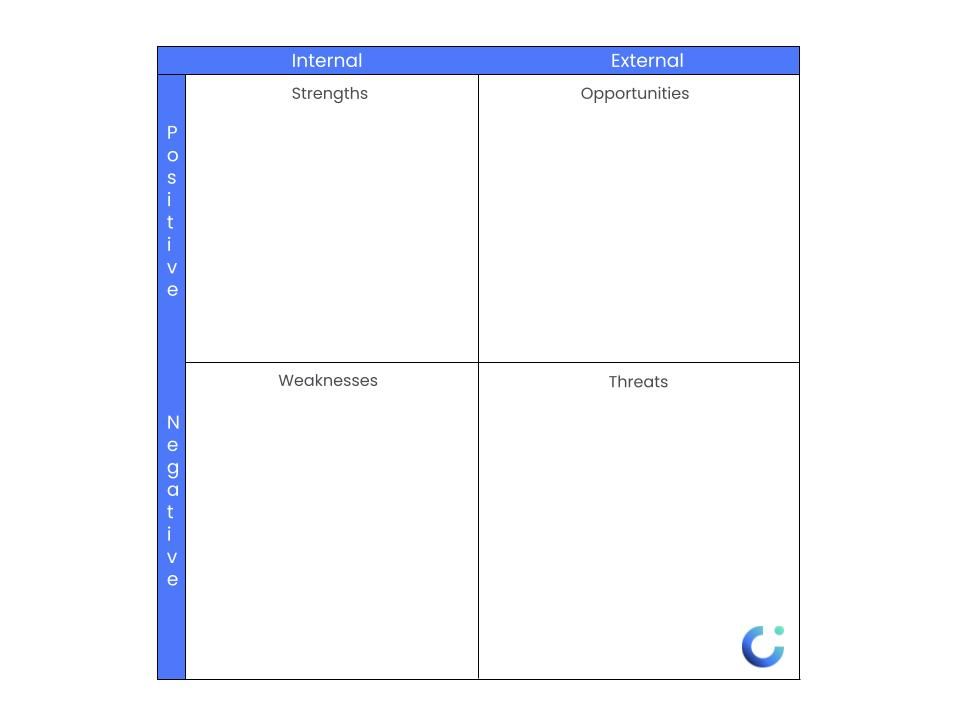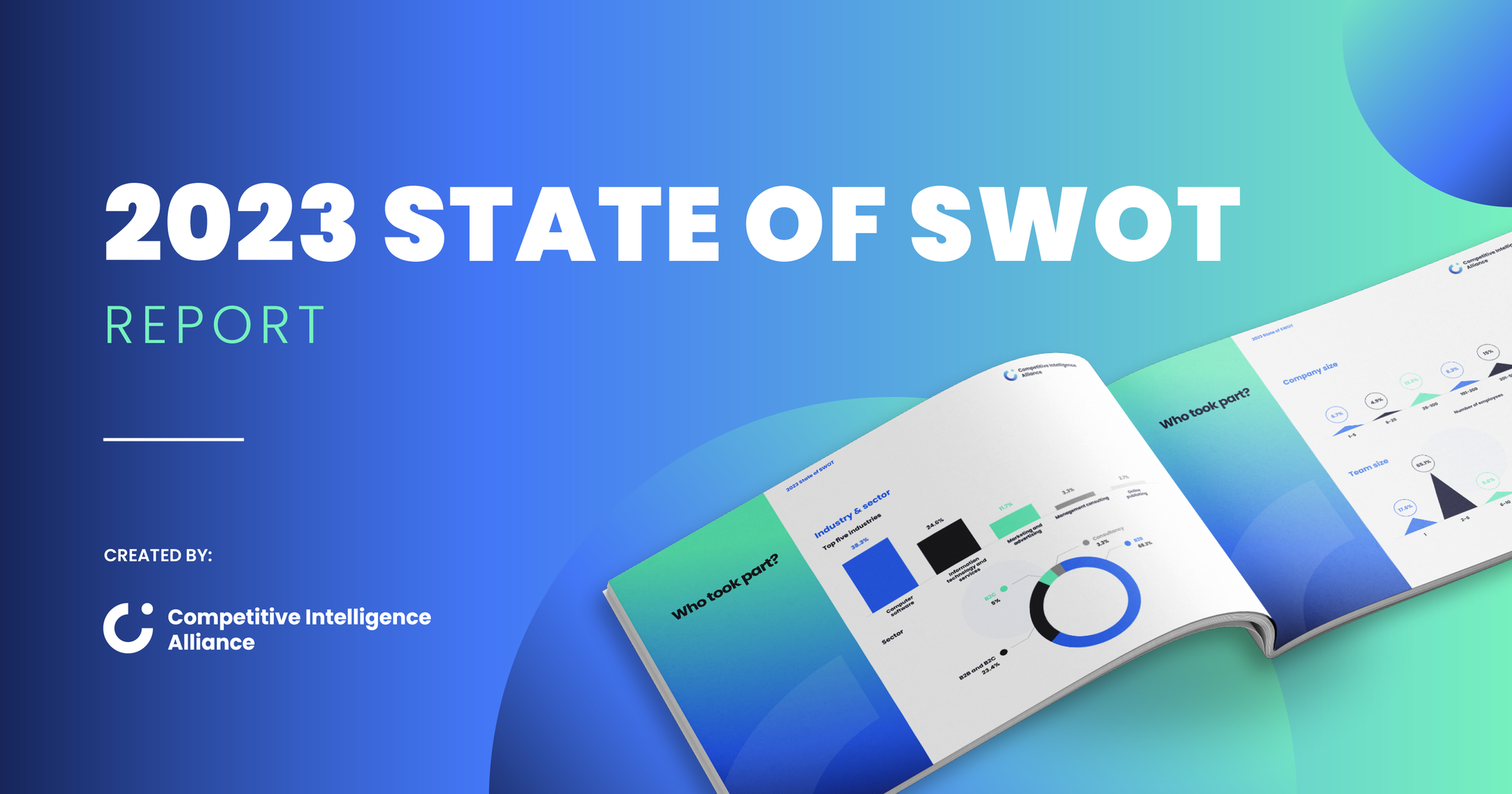Every day, some variation of the above scenario plays out. All kinds of products, hastily chosen, and ill-suited to the needs of a given customer, fail to deliver.
Scenarios like this, driven by mismatched product positioning, or a hardware failure, or a missing feature, can constitute opportunities or threats, depending which side of the battle you’re on.
Figuring out the probabilities of success for your own product lines, and how to improve those probabilities, comes down to being clear on the strengths, weaknesses, opportunities, and threats surrounding a given product.
Want to discover how to do a SWOT analysis of a product? If so, this article is for you.
We’ll teach you everything you need to know about conducting SWOT analysis on your products. We’ll explain:
- What a SWOT analysis is.
- How to perform a SWOT analysis on one of your products.
- Why SWOT analysis is important for strategy professionals.
- An example of a product SWOT analysis.
We’ll even throw in some tips and best practices along the way.
What is a SWOT analysis of a product?
Product SWOT analysis is a strategic planning technique that helps you evaluate the internal and external factors affecting the success of a product. SWOT is an acronym for Strengths, Weaknesses, Opportunities, and Threats.
- Strengths are the positive attributes of your product that give it an advantage over others. These strengths are the reasons why customers pick your product over those of your competitors.
- Weaknesses are the negative aspects of your product that limit its effectiveness or appeal. These are the reasons why customers might dislike your product or choose to switch to an alternative.
- Opportunities are the external factors that create favorable conditions for your product’s growth or success. Take advantage of them to increase your product’s value or market share.
- Threats are the external factors that pose challenges or risks for your product’s survival or profitability. Overcome these risks, or mitigate them, to maintain your product’s position or performance.
| Strengths | Weaknesses | Opportunities | Threats |
| Strength 1 | Weakness 1 | Opportunity 1 | Threat 1 |
| Strength 2 | Weakness 2 | Opportunity 2 | Threat 2 |
| Strength 3 | Weakness 3 | Opportunity 3 | Threat 3 |
How do you perform SWOT analysis on a product?
Here is a SWOT matrix example:
Before you get started, you might be wondering how you’re supposed to organize your findings.
You can use a SWOT matrix to organize and visualize each factor in a table format. Here’s a sample SWOT analysis template to show you how that might look:

Right, let’s get to it. To perform a SWOT analysis on one of your products, follow these five simple steps:
1. Define your product and its objectives.
First, you need to get clear on what your product is, and the problems it aims to solve for your customers. Don’t just focus on features. What are its benefits to members of your target market? Who makes up that target market?
Without getting very clear on these fundamentals, it’ll be impossible to continue with the SWOT analysis. So take the time here to establish the goalposts. What would success look like for this product? With that done, you’ll be able to recognize factors supporting (or standing in the way of) that success.
2. Identify your product’s strengths
Next, you’ll start working your way through each component of the SWOT acronym. As we’ll discuss, you don’t have to start with the strengths. At least not every time. But it’s a sensible starting point nonetheless.
To identify your strengths, ask what makes your product unique or superior. First of all, what’s your product’s unique selling proposition (USP)? What are its competitive advantages?
Customer feedback and field intelligence are invaluable sources of intelligence at this stage. They offer you a more objective view of what your product does well than you’ll be able to get from talking to your colleagues inside the business.
3. Identify your product’s weaknesses
Next, of course, you’ll want to think about weaknesses. What are the drawbacks or limitations of your product? What are its competitive disadvantages?
Win/loss data is great here. Start by speaking to your sales and customer service reps. They’re on the front lines speaking to customers every day, so should have some idea of the common reasons people leave.
Consider speaking to recently churned customers yourself, too, to uncover the reasons why they were tempted away. If it comes down to a missing feature, or a user experience issues, you’re likely to find out.
Not got any win/loss data to work with? Look to your negative reviews. While it’s difficult, try to appraise these reviews honestly. If you can, put yourself in the shoes of the customer.
Even if they’re a rarity, do bad experiences happen enough to hurt your brand’s reputation? What could you do about this? This data-driven approach helps keep you objective and focused on the needs of your customers.

State of SWOT Report
Download your copy to learn...
- The five top challenges you face performing SWOT, and how to solve them.
- The best ways to measure success or failure post-SWOT.
- Whether SWOT is falling out of favor in modern businesses.
- The best alternative frameworks and how they compare with SWOT.
- The future of SWOT analysis.
4. Identify market opportunities for your product
Next, you’ll turn to the opportunities in the market that offer your product lines a chance to shine. Look for emerging trends, developments, and changes.
Here are some example questions to ask to get yourself started:
- Have any gaps opened up in the market recently?
- Are there any unmet customer needs you’re well-placed to meet with a bit of work?
- Are there any new customer segments or niches in the customer pool your product or service could target?
Opportunities can present themselves for all sorts of reasons, so it pays to perform regular market research to stay on top of the latest developments.

5. Identify threats to your product’s success
Finally, take a look at the threats or challenges your product faces.
As external factors (and as we’ll suggest in a little bit), enumerating threats lends itself well to the use of another strategic framework.
A Porter’s Five Forces analysis would serve you particularly well.
Generally, you’ll want to ask yourself about competitors, or alternative or substitute products that could undermine the perceived value of your own. You’ll also look at things like new laws or regulations, or other barriers that hinder your product.
Porter’s Five Forces encapsulate such concerns, the five forces being:
- Threat of industry competition.
- Threat of new entrants.
- Power of suppliers.
- Power of customers.
- Threat of substitute products.
But you don’t have to use another formal framework. Simple methods, like brainstorming, surveys, interviews, and focus groups within the business, but also with your customers or other groups, can help you identify these factors.
6. Look for relationships
You might be done collecting factors for each component of the SWOT, but the work's not done yet. It's time to look for relationships between the factors.
This step is key. Simply listing out factors doesn’t achieve much. Instead, look for ways to exploit market opportunities with your product’s existing strengths. What threats in the marketplace might you nullify if you were to eliminate one or more of your product’s weaknesses with some strategic investment?
Teasing out such relationships is how you move from performing SWOT analysis as a mere intellectual exercise, to something that can help you construct a meaningful strategic plan for your product.
7. Look for alternative perspectives
SWOT analysis is a helpful tool, but it’s not perfect. It’s easy to develop blind spots, or lean too heavily on existing biases, while you’re performing it.
For these reasons, once you’re done with your SWOT analysis, actively look for other perspectives. Where might you be wrong? What might you have missed?
A simple, easy way to get started is to do a TOWS analysis. This is exactly the same as a SWOT analysis, but you’ll start with threats and work backwards towards your strengths. Beginning with the external factors of the analysis, rather than the internal strengths and weaknesses, can help you uncover relationships between factors you might have missed the first time around.
Other frameworks you can use for even more perspective include:
- VRIO analysis.
- Porter’s five forces analysis.
- PESTLE analysis.
Example SWOT analysis of a product
To illustrate how to do a SWOT analysis of a product, let’s use an example of an online course as our product.
Our online course is called “How to Write Engaging Content for Your Website”. It’s a self-paced course that teaches people how to write content that attracts and converts visitors into customers.
Here is an example SWOT analysis for our online course product:
| Strengths | Weaknesses |
| High-quality and practical content | High price and limited access |
| Experienced and qualified instructors | Low interaction and feedback |
| Flexible and convenient format | Technical and compatibility issues |
| Opportunities | Threats |
| Growing demand for online learning | High competition from other online courses |
| Increasing importance of content marketing | Changing trends and standards in content writing |
| Potential partnerships with other websites or platforms | Piracy or plagiarism of course content |
Why is SWOT analysis of products important for strategy professionals?
SWOT analysis of products is important for strategy professionals because it helps them:
A SWOT analysis helps strategy professionals answer questions like:
Is a SWOT analysis for a business or for a product?
A SWOT analysis can be done for either a business, or a product. (In fact, you can even apply SWOT analysis to your projects, or to yourself as an individual.) However, there are some differences between how you’d implement the analysis.
Differences between SWOT analysis for a business and a product
A SWOT analysis for a business focuses on the overall organization and its goals, vision, mission, values, culture, resources, capabilities, and processes.
A SWOT analysis for a product focuses on a specific product offering, and looks at its features, benefits, customers, competitors, and market.
So why, and when, might you choose a SWOT analysis of a product as opposed to a SWOT analysis of your business?
When to choose SWOT for a business vs. for a product
A SWOT analysis for a business can help you evaluate your organization’s strengths, weaknesses, opportunities, and threats in relation to its environment and stakeholders. If you’re looking to put together a strategic plan for the future of your business as a whole, you’ll want to perform a SWOT analysis on the business itself.
A SWOT analysis for a product can help you evaluate your offering’s strengths, weaknesses, opportunities, and threats in relation to its market and customers. When you’re looking to strengthen the competitive advantage of a particular product, you’ll want to perform a SWOT analysis on that product itself.
TL;DR
There you have it. That wraps all you need to know about conducting a SWOT analysis of a product.
Here’s a quick summary of what we’ve learned:
Follow these steps to perform a SWOT analysis on a product:
- Define what success looks like for your product.
- Identify your product’s strengths.
- Identify your product’s weaknesses.
- Identify your product’s opportunities.
- Identify your product’s threats.
- Don’t forget to actively seek new perspectives, and to tease out relationships between factors.
- Organize and visualize your factors in a table format using a SWOT matrix.
- Use this information to create a strategic plan for improving your product’s success in your competitive environment.
Download the State of SWOT Report
We had far more questions about SWOT analysis for our survey-takers.
🎯 Which SWOT applications offer the best ROI?
👍 How do you measure the success or failure of a SWOT analysis?
🔮 What does the future hold for SWOT analysis? And how do you overcome its inherent challenges?
Want to dig deeper into the reasons why modern attitudes towards SWOT are the way they are? Want to read the real comments and opinions of practitioners to learn how to improve your own application of strategic frameworks in your business?
Grab your no-cost copy of the report today and upgrade your competitive intelligence toolkit. 🧰






.png?v=09cf73b4b5)